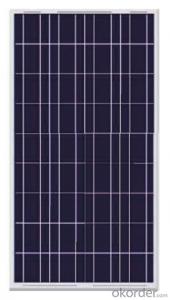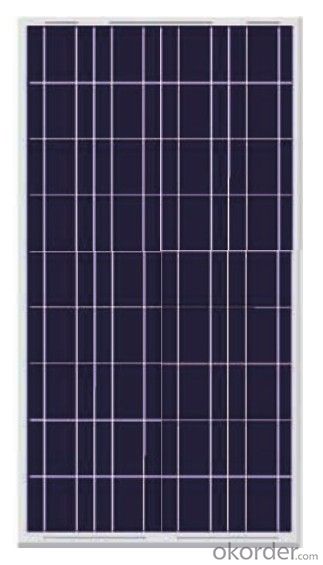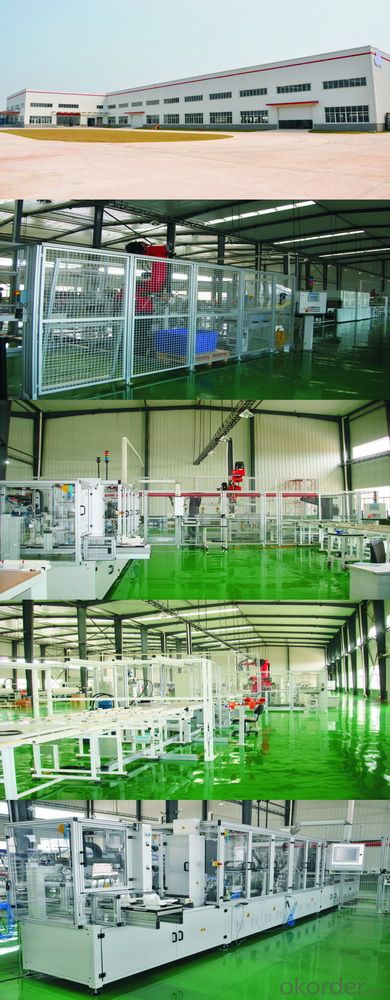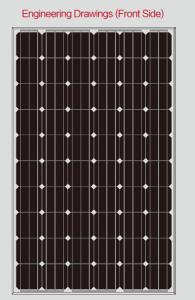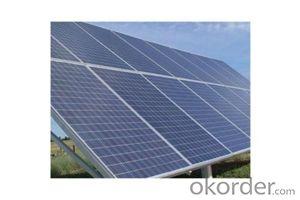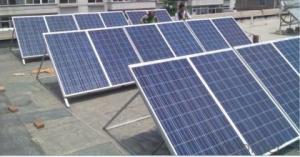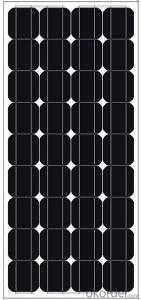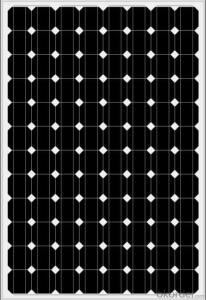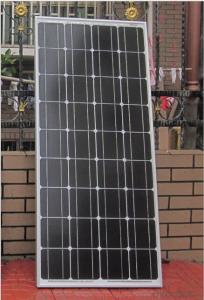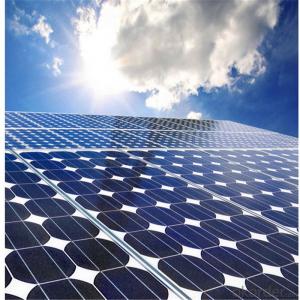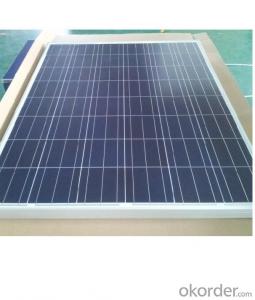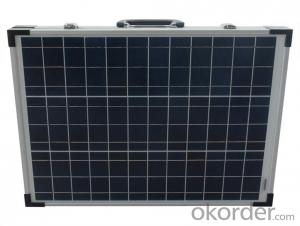Solar Panels Mn Polycrystal Photovoltaic (PV) Panel 100W
- Loading Port:
- Shekou
- Payment Terms:
- TT or LC
- Min Order Qty:
- -
- Supply Capability:
- 5000 watt/month
OKorder Service Pledge
OKorder Financial Service
You Might Also Like
What is the product?
Solar Polycrystalline Series Panels
Introduction of Solar Monocrystalline Series Panels
CNBM Solar photovoltaic (PV) Panel is designed for large electrical power requirements. It is the optimal choice for both on-grid and off-grid power systems. CNBM Solar panel offers high performance of power per square foot of solar array. Monocrystalline silicon(c-Si): often made using the Czochralski process. Single-crystal wafer cells tend to be expensive, and because they are cut from cylindrical ingots, do not completely cover a square solar cell module without a substantial waste of refined silicon. Hence most c-Si panels have uncovered gaps at the four corners of the cells.
Characteristics of Solar Polycrystalline Series Panels
I Solar Cell : High efficiency crystalline solar cell. Even if under the weak light, the solar module can produce maximum power output.
II EVA and TPT: Using high quality EVA and TPT to prevent destroying and water.
IIIAI frame: Without screw, corner connection. 6 holes on the frame can be installed easily.
IV Junction box: Multi function junction box with water proof.
V Good performance of preventing from atrocious weather such as wind and hails.
VI Resisting moisture and etching effectively, not effected by geology.
Advantages of Solar Polycrystalline Series Panels
• CNBM Solar performance guarantees for 25 years
• Timeliness of delivery
CNBM International Corporation's products including Monocrystalline Solar Panel, Polycrystalline Solar Panel have received and enjoyed famous reputation in many countries and regions in the world .As a solar panel supplier in China, we strive to provide our customers with excellent service, superior products and unmatched value.
Mechanical Data Solar Monocrystalline Series
Power | 120W/130W |
Dimension | 1190/1470×670×30mm |
Weight | 9.5kg/11.7kg |
Tolerance | ±3% |
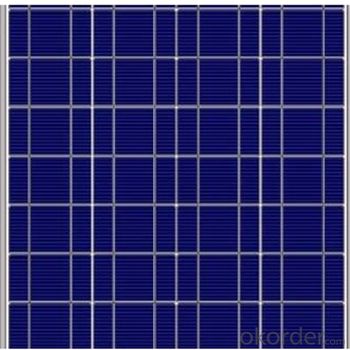
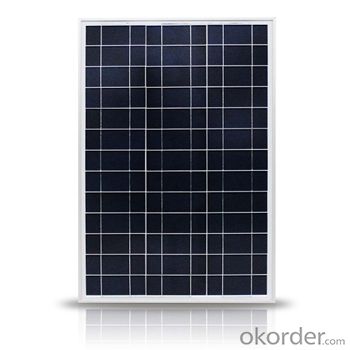
FAQ:
1. How do you pack your products?
We have rich experience on how to pack the panels to make sure the safety on shipment when it arrives at the destination.
2. Can you do FOB for us?
Yes, we can do it for you .
3. How long can we receive the goods after purchase?
In the purchase of product within three working days, We will arrange the factory delivery as soon as possible. The perfect time of receiving is related to the state and position of customers. Commonly 7 to 10 working days can be served.
- Q: where I can find solar panel the has 4.8 volts? Like those solar walkway light or something that has 4.8 volts solar panel.Do you think I can get it from home depot?
- How Solar Cells Work by Scott Aldous Inside This Article . Introduction to How Solar Cells Work 2. Photovoltaic Cells: Converting Photons to Electrons 3. How Silicon Makes a Solar Cell 4. Anatomy of a Solar Cell 5. Energy Loss in a Solar Cell 6. Solar-powering a House 7. Solving Solar-power Issues 8. Solar-power Pros and Cons 9. Lots More Information 0. See all Physical Science articles You've probably seen calculators that have solar cells -- calculators that never need batteries, and in some cases don't even have an off button. As long as you have enough light, they seem to work forever. You may have seen larger solar panels -- on emergency road signs or call boxes, on buoys, even in parking lots to power lights. Although these larger panels aren't as common as solar powered calculators, they're out there, and not that hard to spot if you know where to look. There are solar cell arrays on satellites, where they are used to power the electrical systems. You have probably also been hearing about the solar revolution for the last 20 years -- the idea that one day we will all use free electricity from the sun. This is a seductive promise: On a bright, sunny day, the sun shines approximately ,000 watts of energy per square meter of the planet's surface, and if we could collect all of that energy we could easily power our homes and offices for free.
- Q: Can solar panels be installed on an RV or camper?
- Yes, solar panels can be installed on an RV or camper. This allows you to harness the power of the sun to generate electricity and charge your batteries, making your RV or camper more self-sufficient and reducing reliance on traditional power sources.
- Q: How do solar panels affect the electricity bill?
- Solar panels can significantly reduce or even eliminate electricity bills by generating clean and renewable energy from the sun. By harnessing solar power, these panels can offset a portion or all of a household's electricity consumption, thereby reducing the amount of power needed from the utility grid. This ultimately leads to lower electricity bills and potential savings over the long term.
- Q: I had an idea for new parabolic solar panels shaped like horseshoes. They can install them outside buildings facing the equator. They could angle them from the ground based on how many degrees latitude the location and rotate them according to seasonal changes. The disadvantage of photovoltaic panels is that they are not all capable of receiving direct sunlight. That is the quintessential reason I believe horseshoe solar panels are more effective than flat rectangular ones. One side could function in the morning; the middle could perform at midday; and the other could operate during the evening. That method seems more sensible than hourly positioning. I'm certain horseshoe panels could save and produce more electricity. A football stadium, shopping mall, or outlet center would be a fantastic place. What do you think?
- Sounds like you are thinking which is excellent. Now do a controlled experiment. Using a prototype of your receiver and measure it against existing technology. You could do a computerized mock up.
- Q: I need to know how do solar panels work. I need to know what are they made of.
- The term solar panel is best applied to a flat solar thermal collector, such as a solar hot water or air panel used to heat water, air, or otherwise collect solar thermal energy. But 'solar panel' may also refer to a photovoltaic module which is an assembly of solar cells used to generate electricity. In all cases, the panels are typically flat, and are available in various heights and widths.
- Q: So I want to go completely solar. Do I need the connected solar panels alone for after sundown hours; Do I need something else in order to have energy to run my entire house throughout the night?In other words do solar panels store the energy for after sun-down or do I need other devices to store the energy?
- Unless okorder
- Q: how much power is generated with solar panels? also please give me links for that information.and how much would the costs be for this alternative energy source?
- If you put 'solar world statistics' into a search engine, you will discover that there are many statistics that are being heavily contested. Picking up the truth from among hype is the task. Solar panels typically have a rated maximum output of about 0 watts per sq metre. But actual delivery to grids of kWh would point to a number closer to 4 watts / sq M. on a 24 hour basis. Grid management is thus cautious about yield claims when history points to only /8 of rated maximum output. There may be some inappropriate expectations, when a solar roof is first powering the building, and only selling excess to the grid.
- Q: I want to know that, is there any thing likehow much charge we can get per square feet. in a solar panel.let me know.also, I will appreciate if reference are given.
- I found some 0 square ft. solar panels that produce 30 watts . 3 watts per s.f. . A 2,000 s.f. home would consume around 2,000 kilowatt hours of electricity in summer months in areas that require air conditioning . This would require 67 kwh daily . You would need ,000 s.f. of panels and dozens of batteries to store the energy for night time .
- Q: Can solar panels be used in areas with high levels of radiofrequency interference?
- Yes, solar panels can be used in areas with high levels of radiofrequency interference. However, it is important to note that radiofrequency interference may affect the performance of solar panels and reduce their efficiency. Proper shielding and grounding techniques can be employed to minimize the impact of radiofrequency interference on solar panel operations.
- Q: Are there any noise or sound-related issues with solar panels?
- No, solar panels do not produce any noise or sound-related issues as they operate silently.
Send your message to us
Solar Panels Mn Polycrystal Photovoltaic (PV) Panel 100W
- Loading Port:
- Shekou
- Payment Terms:
- TT or LC
- Min Order Qty:
- -
- Supply Capability:
- 5000 watt/month
OKorder Service Pledge
OKorder Financial Service
Similar products
Hot products
Hot Searches
Related keywords
